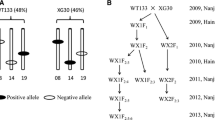Abstract
Soybean is a major source of protein meal in the world. Soybean kunitz trypsin inhibitor (SKTI) protein is a responsible for the inferior nutritional quality of unheated or incompletely heated soybean meal. The primary objective of this research was to identify DNA markers linked to the Ti locus controlling presence and absence of kunitz trypsin inhibitor protein. Two mapping populations were developed. Population 1 was derived from a cross between cultivar Jinpumkong2 (TiTi) and C242 (titi). Population 2 was made from a mating between cultivar Clark (TiTi) and C242. The F1 plants were grown in the greenhouse to produce F2 seeds. Each F2 seed from F1 plants was analyzed electrophoretically to determine the presence of the SKTI protein band. One-thousand RAPD primers, 342 AFLP primer sets, and 35 SSR primers were used to map Ti locus in population 1 and 2. The presence of SKTI protein was dominant to the lack of a SKTI protein and kunitz trypsin inhibit protein band was controlled by a single locus. Twelve DNA markers (4 RAPD, 4 AFLP, and 3 SSR) and Ti locus were found to be genetically linked in population 1 consisted with 94 F2 individual plants. Three SSR markers (Satt409, Satt228, and Satt429) were linked with Ti locus within 10 cM. Satt228 marker was tightly linked with Ti locus. Satt228 marker was tightly linked within 0–3.7 cM of the Ti locus and may be useful in a marker assisted selection program.
Similar content being viewed by others
References
Akkaya MS, Bhagwat AA, Cregan PB (1995) Length polymorphism of simple sequence repeat DNA in soybean. Genetics 132:1131–1139
Apuya NR, Frazier BL, Keim P, Roth EJ, Lark KG (1988) Restriction fragment length polymorphism as genetic markers in soybean. Theor Appl Genet 75:889–901
Birk Y (1961) Purification and some properties of a highly active inhibitor of trypsin and chymotrypsin from soybeans. Biochem Biophys Acta 54:378–381
Cregan PB, Jarvik T, Bush AL, Shoemaker RC, Lark KG, Kahler AL, Kaya N, VanToai TT, Lohnes DG, Jongil Chung, Specht JE (1999) An integrated genetic linkage map of the soybean genome. Crop Sci.39:1464–1490
Frattali V, Steiner RF (1968) Soybean inhibitor. I. Separations and some properties of three inhibitors from commercial crude soybean trypsin inhibitors. Biochemistry 7:521–530
Hidebrand DF, Orf JH, Hymowitz T (1980) Inheritance of an acid phosphatase and its linkage with the Kunitz trypsin inhibitor in seed protein of soybeans. Crop Sci 20:83–85
Hymowitz T., Hadley HH (1972) Inheritance of a trypsin inhibitor variant in seed protein of soybeans. Crop Sci 12:197–198
Keim PJ, Schupp M, Travis SE, Clayton K, Zhu T, Shi L, Ferreira A, Webb DM (1997) A high density soybean genetic map based on AFLP markers. Crop Sci 37:537–543
Kiang YT (1987) Mapping three protein loci on a soybean chromosome. Crop Sci 27:44–46
Kim MS, Park MJ, Hwang JG, Jo SH, Ko MS, Chung JI (2004) Identification of molecular markers linked to Ti locus in soybean. Korean J Crop Sci 49(5):419–422
Kim MS, Cho YJ, Park DJ, Han SJ, Oh JH, Hwang JG, Ko MS, Chung JI (2003) Construction of genetic linkage map for korean soybean genotypes using molecular markers. Korean J Crop Sci 48(4):297–302
Kosambi DD (1944) The estimation of map distance from recombination values. Ann. Eugen. 12:172–175
Kunitz M (1945) Crystallization of a soybean trypsin inhibitor from soybean. Science 101:668–669
Lander E., Green P, Abrahamson J, Barlow A, Daly MJ, Lincoln SE, Newburg L (1987) MAPMAKER: an interactive computer package for constructing primary genetic linkage maps of experiment and natural populations. Genomics 1:174–181
Lark KG, Weisemen JM, Mathews BF, Palmer R, Chase K, Macalma T (1993) A genetic map of soybean using an intraspecific cross of two cultivars: ‘Minsoy’ and ‘Noir’. Theor Appl Genet 86:901–906
Michelmore RW, Paran J, Kesseli RV (1991) Identification of markers linked to disease resistance genes by bulked segregant analysis: A rapid method to detect markers in specific genomic regions by using segregation populations. Proc Natl Acad Sci 88:9828–9832
Orf JH, Hymowitz T (1979) Inheritance of the absence of the Kunitz trypsin inhibitor in seed protein of soybeans. Crop Sci 19:107–109
Rackis JJ, Sasame HA, Mann RR, Anderson RL, Smith AK (1962) Soybean trypsin inhibitors: Isolation, purification and physical properties. Arch Biochem Biophys 98:471–478
Shoemaker RC, Specht JE (1995) Integration of the soybean molecular and classical genetic linkage groups. Crop Sci. 35:436–446
Singh L, Wilson CM, Hadley HH (1969) Genetic differences in soybean trypsin inhibitors separated by disc electrophoresis. Crop Sci 9:489–491
Saghai Maroof MA, Soliman KM, Jorgensen RA, Allard RW (1984) Ribosomal DNA spacer-length polymorphisms in barley: Mendelian inheritance, chromosomal location and population dynamics. Proc Natl Acad Sci 81:8014–8018
Westfall RL, Hauge SM (1948) The nutritive quality and the trypsin inhibitor content of soybean flour heated at various temperatures. J Nutr 35:379–389
Acknowledgment
This work was supported by a grant (CG 3122) from Functional Genomics Center (CFGC), 21C Frontier R & D Project, Ministry of Science & Technology, Korea.
Author information
Authors and Affiliations
Corresponding author
Rights and permissions
About this article
Cite this article
Kim, M.S., Park, M.J., Jeong, W.H. et al. SSR marker tightly linked to the Ti locus in Soybean [Glycine max (L.) Merr.]. Euphytica 152, 361–366 (2006). https://doi.org/10.1007/s10681-006-9223-3
Received:
Accepted:
Published:
Issue Date:
DOI: https://doi.org/10.1007/s10681-006-9223-3




